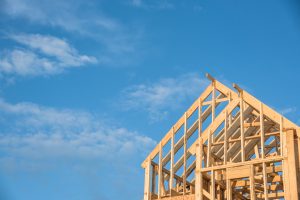 The U.S. Census Bureau and the U.S. Department of Housing and Urban Development have released their new residential construction statistics for February 2022, which found that privately‐owned housing starts in February hit 1,769,000, 6.8% above the revised January estimate of 1,657,000. This was 22.3% above February 2021’s housing starts rate of 1,447,000.
The U.S. Census Bureau and the U.S. Department of Housing and Urban Development have released their new residential construction statistics for February 2022, which found that privately‐owned housing starts in February hit 1,769,000, 6.8% above the revised January estimate of 1,657,000. This was 22.3% above February 2021’s housing starts rate of 1,447,000.
Single‐family housing starts in February were at a rate of 1,215,000, 5.7% above the revised January figure of 1,054,000. The February rate for units in buildings with five units or more was 501,000.
“Today’s new residential construction report from the Census Bureau showed housing starts rising 6.8% over the month of February on a seasonally adjusted basis to a rate of 1.77 million annualized units,” said Fannie Mae’s Chief Economist Doug Duncan. “The pace eclipsed December’s recent high and represented the fastest since mid-2006. Both single-family and multifamily starts contributed to the topline number, rising 5.7% and 9.3%, respectively.”
“The strength in single-family construction was expected as a surge in new home sales occurred in December and January due in part to what we believe to be many homebuyers rushing to lock in their purchases as they anticipated mortgage rates soon rising,” Duncan continued. “Given that homebuilders have continued to struggle to work through their order backlogs in light of materials and labor scarcity issues, there’s still strong near-term support for new housing construction. Meanwhile, multifamily starts continued to impress as they rose above our expectations. This is more evidence of the ongoing interest in multifamily housing development due to strong rent gains and low vacancy rates.”
According to the report, privately‐owned housing units authorized by building permits in February were at a seasonally adjusted annual rate of 1,859,000. This is 1.9% below the revised January rate of 1,895,000, but is 7.7% above the February 2021 rate of 1,726,000. Single‐family authorizations in February were at a rate of 1,207,000 while authorizations of units in buildings with five units or more were at a rate of 597,000.
Privately‐owned housing completions in February were at a seasonally adjusted annual rate of 1,309,000, up 5.9% from the January estimate of 1,236,000. Single‐family housing completions in February were at a rate of 1,034,000, 12.1% higher than the revised January rate of 922,000.
“What remains to be seen, however, is how housing reacts moving forward as the effects of upward-moving mortgage rates begin to be felt,” Duncan concluded. “Given the historical relationship to mortgage rate changes, we wouldn’t expect recent rises to meaningfully dampen housing demand for some months. In fact, homebuilder surveys continue to show strong levels of prospective foot traffic so far this year. Even though we expect total home sales to slow over the course of the year, we anticipate that new home construction will remain comparatively resilient given the ongoing lack of supply of existing homes for sale and the current outsized backlog of orders.”
First American Deputy Chief Economist Odeta Kushi was also impressed with the results, but felt that supply chain issues are still affecting the data.
“Housing starts increase to 1.769 million (SAAR) in February. Single-family housing starts increase 5.7% on monthly basis, while the rate for units in buildings with 5 or more units increased 0.8%. More groundbreaking is welcome news for a supply starved housing market,” Kushi said. “The 12% month over month increase in single-family completions signals a pickup in immediate housing supply relief. However, it’s important to note the gap between starts and completions, which is much higher than pre-pandemic and partially due to supply shortages of construction inputs delay the delivery of finished homes.”
“It’s great to see both housing starts and completions up. Permits, a leading indicator of future starts, is down modestly month over month as builders grow concerned about affordability challenges ahead as rates continue to rise,” Kushi continued. “But record low existing-home inventory and millennial demand is supportive of new construction. Of course, builders face persistent headwinds that make it difficult to bring more new homes to the market.”
“Lack of labor and materials are persistent headwinds to increasing the pace of new construction. The number of single-family homes authorized, but not started was 25% higher year over year and up 2% month over month—builders have a backlog of uncompleted homes to get through before they can break ground on new projects.”
“The number of single-family homes under construction increased to the highest level since 2006. While builders are continuing to push to meet demand, supply-side headwinds slow the home-building momentum at a time when the housing market desperately needs more supply relief,” Kushi concluded. “Declining affordability is the other concern. As mortgage rates rise, all else held equal, house-buying power falls. Homebuilder confidence fell in March as builders continue to face supply chain disruptions, price increases, and concerns that declining affordability will price out buyers.”
Click here to see the report in its entirety.

 DSNews The homepage of the servicing industry
DSNews The homepage of the servicing industry









